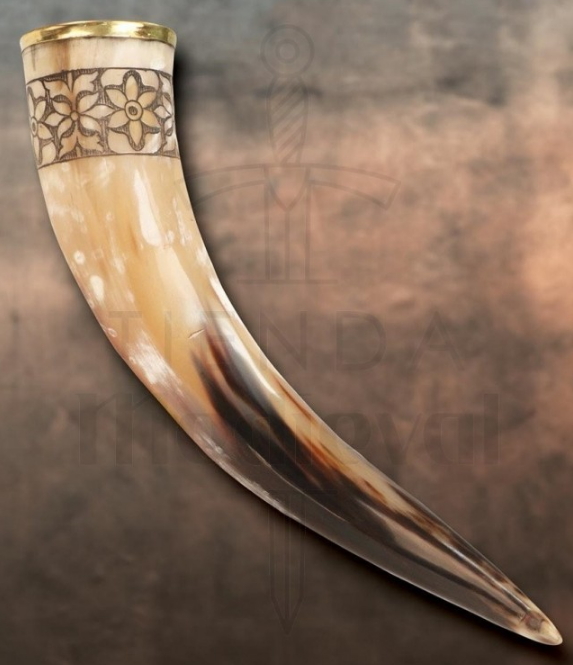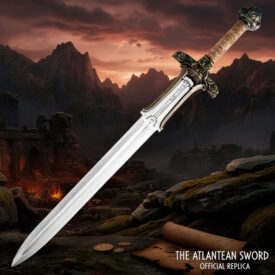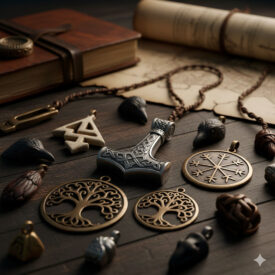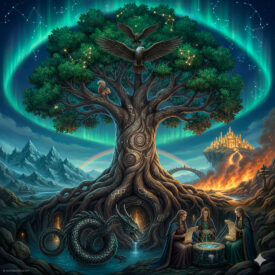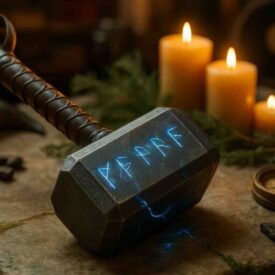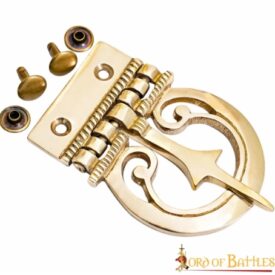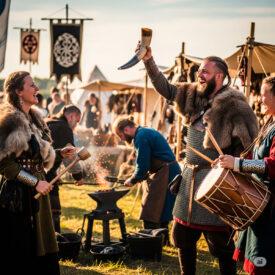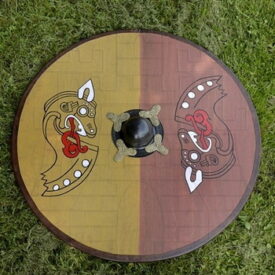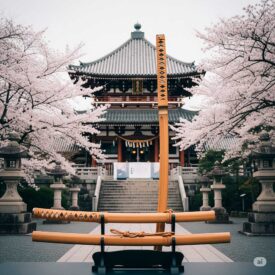The Viking drinking horn is an image that has reached us charged with emotion: warriors toasting, mead halls, and myths that seem to leap from sagas. But behind that icon is a real object, processed by artisan hands, with practical, ceremonial, and symbolic uses. In this article, you’ll find the history, manufacturing process, symbolism, archaeological examples, how to choose and care for a horn today, and how to integrate it into events or collections.
Why do we associate horns with Vikings?
The scene of the Norse warrior raising a horn full of mead has become a cultural icon, but it’s worth separating what’s proven from what’s romantic. Horns were present in the material life of the northern peoples: as vessels, ceremonial objects, and, occasionally, as sound instruments. However, the image of helmets with horns is a later artistic invention that has no archaeological support.
Debunking a myth: horned helmets
The idea of Viking helmets with horns comes mainly from the romantic imagination of the 19th century and from shows like opera. Archaeological records offer, for example, the Gjermundbu helmet in Norway, which shows that Viking helmets were functional pieces of protection, not supports for bulky ornaments. This does not detract from the value of horns as independent objects; on the contrary, it places them in their real context: cups, ritual vessels, and bugles.
Origins and materials: what were the horns made of?
The use of horns as vessels predates the Vikings, but during the Viking Age (approx. 800–1050 A.D.) these objects acquired distinctive cultural features and functions. The most common raw material was domestic cattle horns; sometimes larger horns were used, but most came from ordinary-sized bovines.
The manufacturing process combined very specific techniques: cleaning and disinfecting the interior, removing tissues, heating to mold and facilitate polishing, and in high-ranking pieces, incorporating metal inlays or engravings. These treatments not only improved their appearance but also their durability in contact with beverages like mead.
Archaeological evidence and emblematic finds
Excavations in funerary contexts and ships such as Oseberg and Gokstad have yielded remains and ornaments associated with horns, confirming their social importance. Although organic matter is preserved worse than metal, metal applications and archaeological remains allow us to reconstruct in detail their presence in banquets and rituals.
Craftsmanship and style: from simple to elaborate
Viking horns show remarkable diversity: from functional and unadorned pieces to lavishly decorated cups with precious metals, runes, and mythological motifs. The decoration served to indicate status, origins, or ritual functions.
Social and ritual uses of Viking drinking horns
Communal halls or mead halls were centers of social and political life. In these spaces, passing a horn from hand to hand was a unifying practice: an act of hospitality that reinforced alliances and hierarchies. Ritual toasts —the minni— honored gods, leaders, and ancestors, and could formalize pacts whose breach had serious consequences in the community.
Symbols of status, wisdom, and mythology
The size and ornamentation of a horn reflected social status. The most elaborate ones, with inlays or runes, belonged to high-ranking individuals. In Norse mythology, horns have symbolic roles: Odin’s Triple Horn is an emblem of poetic wisdom, while Gjallarhorn, associated with Heimdall, represents the ability to announce events of enormous significance.
Horns as signaling instruments
Not all horns were drinking vessels. Some, of large size and open design, functioned as bugles or trumpets. Their sound range allowed them to communicate warnings, summons, or alarms over considerable distances, both at sea and on land.
Manufacturing techniques: the artisan’s work
The manufacture of a horn involved technical controls and aesthetic decisions: selecting the piece, cleaning the interior, removing marrow and organic parts, heating to mold the opening, and polishing the surface. For the horn to be suitable for liquids, natural varnishes or food-grade resins were applied to the interior.
Decoration and motifs
Motifs could be geometric, mythological scenes, or runic inscriptions with protective or commemorative functions. These ornamentations narrated stories, affiliations, and achievements, turning each horn into a personal and communicative piece.
Practical comparison: types of horns and uses
| Horn type | Main use | Interior finish | Level of detail |
|---|---|---|---|
| Varnished horn | Regular drinking | Food-grade varnish | Low-medium |
| Natural horn (unvarnished) | Decoration, collection | Requires lining | Medium-high |
| Decorated horn (inlays) | Ceremonial and display | May have partial varnish | High |
| Sounding horn (bugle) | Signaling and recreation | Not necessary | Low |
How to choose a Viking drinking horn
Choosing a horn involves balancing aesthetics, use, and practicality. Here are the key factors to consider:
- Size and capacity: define if you want it for frequent use, occasional toasts, or decoration.
- Interior finish: for daily drinking, prioritize food-grade varnish or a safe lining.
- Authenticity and decoration: decide if you prefer a historical replica (with runes or motifs) or a more modern design.
- Origin and craftsmanship: a handcrafted piece offers quality and a richer history.
Comparative table: modernity vs. historical replica
| Aspect | Historical replica | Modern model |
|---|---|---|
| Drinking functionality | May require varnish | Varnish and food-grade finish |
| Decoration | High, with historical motifs | Variable, from simple to elaborate |
| Price | Medium-high | Wide range |
| Suitability for reenactments | High | Depends on the model |
How to care for and preserve a horn
Cleaning: Wash it by hand with lukewarm water and mild soap; avoid soaking it and never use dishwashers or microwaves. Rinse well to remove any drink residue.
Drying and storage: Dry it immediately and let it breathe at room temperature. Store it in a position that does not deform its natural curvature and avoid direct heat sources.
Material maintenance: If the interior is not varnished, occasionally apply food-grade oil or specific wax for wood/bone; this nourishes the piece and prolongs its life. Avoid harsh chemicals.
Reenactments, events, and contemporary use
At historical festivals, fairs, and performances, Viking horns are central elements for creating atmosphere. They are combined with costumes, rustic tableware, and menus inspired by ancient recipes to achieve an immersive experience.
For event use, select varnished horns for food safety and durability; if used for sound, choose models designed to project and withstand outdoor use.
Practical tips for events
- Before the event, check that the interior is perfectly clean and, if applicable, fill it with the chosen beverage shortly before the toast.
- For symbolic ceremonies, inform participants about the cultural significance of the toast and the correct way to hold and pass the horn.
- If you are going to sell or give away horns at events, offer them with printed care instructions and availability of food-grade varnish in our online store.
Common mistakes and how to avoid them
A common mistake is to think that all horns are suitable for drinking without preparation. Always check the interior finish. Another common mistake is to expose the piece to abrupt changes in temperature or humidity, which can cause cracks or deformations.
To avoid problems, buy from our online store where each product includes specifications on finish, use recommendations, and maintenance.
The role of horns in cultural memory
Viking horns have survived in the collective imagination because they condense values such as camaraderie, hospitality, and honor. As objects that united the practical and the sacred, they continue to arouse interest: collectors, reenactors, and history lovers seek pieces that allow them to touch a millenary tradition.
Final recommendations for enthusiasts
If you are passionate about Norse culture, combine reading historical sources with acquiring quality replicas. Prioritize pieces with information about materials and craftsmanship; support artisan work when buying and, when possible, choose models with food-grade varnish if you intend to drink from them.
By choosing a Viking drinking horn, you connect with a practice that was both everyday and symbolic. This mixture of utility, history, and beauty is what explains why these objects continue to fascinate so many centuries later.
VIEW VIKING HORNS FOR DRINKING OR SOUND | VISIT YOUR VIKING STORE


